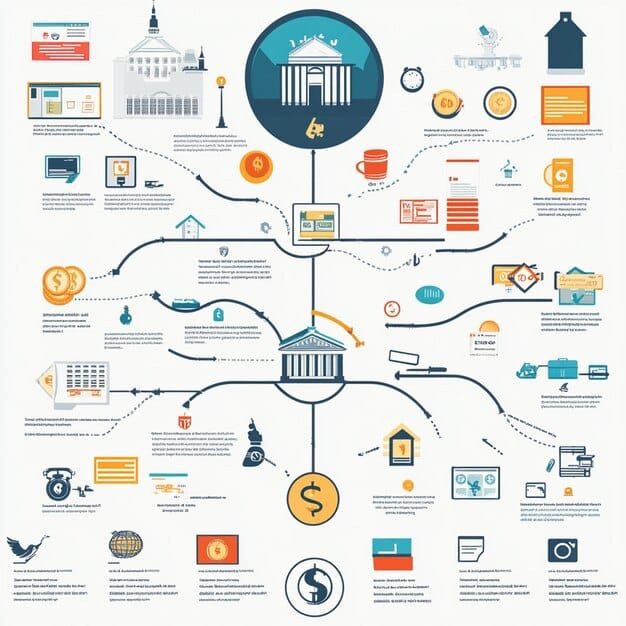Regulatory Risks for Altcoins: A US 2025 Compliance Checklist

Regulatory Risks for Altcoins in the US: A 2025 Compliance Checklist outlines the crucial steps altcoin projects must take to navigate the evolving legal landscape, covering everything from SEC guidelines to potential legislative changes and offering a practical compliance strategy for sustained operation in the United States.
Navigating the regulatory landscape for altcoins in the US can feel like traversing a minefield, especially with the rapid evolution of laws and policies. This article provides a Regulatory Risks for Altcoins in the US: A 2025 Compliance Checklist to help altcoin projects understand and prepare for the challenges ahead, ensuring they can thrive in the US market.
Understanding the Evolving Regulatory Landscape for Altcoins
The regulatory environment for altcoins in the United States is far from static; it’s a dynamic space characterized by ongoing debates, interpretations, and enforcement actions. To effectively navigate this landscape, altcoin projects need a clear understanding of the key players and legislative frameworks shaping the industry.
Key Regulatory Bodies and Their Focus
Several regulatory bodies play a pivotal role in shaping the rules governing altcoins. These agencies each have specific areas of focus and contribute uniquely to the overarching regulatory framework.
- Securities and Exchange Commission (SEC): The SEC primarily focuses on whether altcoins should be classified as securities. Tokens deemed securities are subject to stringent registration and compliance requirements, impacting fundraising and operational practices.
- Commodity Futures Trading Commission (CFTC): The CFTC asserts authority over digital assets classified as commodities. This involves oversight of derivatives trading and market manipulation prevention, impacting altcoins with futures or options markets.
- Financial Crimes Enforcement Network (FinCEN): FinCEN focuses on preventing money laundering and terrorist financing through digital assets. Altcoins operating as money transmitters must comply with Bank Secrecy Act (BSA) regulations.
Current Legislation and Its Impact on Altcoins
Existing legislation, although not explicitly designed for digital assets, has a significant impact on the altcoin market. Understanding these laws is crucial for compliance.
- Securities Act of 1933 and Securities Exchange Act of 1934: These acts form the basis for SEC oversight of securities offerings and trading. Applying these laws to altcoins requires careful analysis of whether a token qualifies as a security under the Howey Test.
- Bank Secrecy Act (BSA): The BSA requires financial institutions, including certain altcoin platforms, to implement anti-money laundering (AML) programs. This involves KYC (Know Your Customer) procedures and reporting suspicious activities.
- Tax Regulations: The IRS treats cryptocurrencies as property for tax purposes. Altcoin transactions are subject to capital gains taxes, and businesses must navigate complexities related to income recognition and reporting.

In conclusion, the regulatory landscape for altcoins is complex and involves multiple agencies and existing legislation. A proactive and informed approach to compliance is essential for altcoin projects to operate legally and sustainably in the US.
Key Compliance Areas for Altcoins in 2025
For altcoin projects to remain compliant and operational in the US by 2025, several key areas require focused attention. These compliance areas span securities regulations, anti-money laundering (AML) measures, and consumer protection standards.
Securities Compliance and the Howey Test
Determining whether an altcoin is a security is paramount. The Howey Test, derived from the Supreme Court case SEC v. W.J. Howey Co., is the standard used to assess this.
An investment contract exists if there is:
- An investment of money
- In a common enterprise
- With the expectation of profit
- Derived from the efforts of others
If an altcoin offering meets these criteria, it is likely to be considered a security and must comply with SEC regulations, which may include registration requirements or exemptions like Regulation D.
AML and KYC Compliance
Complying with AML and KYC regulations is critical for preventing illicit activities. This involves implementing robust procedures to verify customer identities and monitor transactions.
To achieve AML/KYC compliance, altcoin projects should:
* Implement Customer Identification Program (CIP) to verify the identity of users.
* Conduct ongoing monitoring of transactions to detect and report suspicious activities.
* File Suspicious Activity Reports (SARs) with FinCEN as required.
Consumer Protection and Transparency
Protecting consumers and ensuring transparency are vital for maintaining trust and avoiding regulatory scrutiny. This involves providing clear and accurate information about altcoin projects.
Altcoin projects should prioritize:
- Providing clear disclosures about the risks associated with investing in altcoins.
- Ensuring transparency in tokenomics and governance.
- Establishing mechanisms for conflict resolution and consumer redress.

In conclusion, key compliance areas for altcoins in 2025 include securities compliance, AML/KYC measures, and consumer protection. By prioritizing these areas, altcoin projects can navigate the regulatory landscape effectively and maintain a sustainable presence in the US market.
Preparing for Potential Legislative Changes
The regulatory landscape for altcoins is not only shaped by existing laws and regulations but also by potential legislative changes. Staying informed about proposed legislation and actively engaging with policymakers is crucial for altcoin projects.
Monitoring Proposed Legislation
Keeping a close watch on proposed legislation at both the federal and state levels is essential. Key areas to monitor include:
* Digital Asset Regulations: Proposed laws that specifically address digital assets, including altcoins, are of utmost importance. These laws may define which altcoins are securities, commodities, or neither, and set corresponding regulatory requirements.
* Stablecoin Legislation: Regulatory developments around stablecoins can impact altcoins that are used in conjunction with or as alternatives to stablecoins.
* Tax Laws: Changes to tax laws pertaining to digital assets can affect how altcoins are treated for capital gains, income, and other tax purposes.
Engaging with Policymakers and Industry Groups
Actively engaging with policymakers and participating in industry groups can help shape the regulatory landscape for altcoins. This engagement can take various forms, including:
* Lobbying: Direct engagement with legislators to advocate for favorable regulatory outcomes.
* Public Comments: Submitting comments on proposed rules and regulations to provide input and expertise.
* Industry Associations: Joining industry associations and working with other stakeholders to develop best practices and promote responsible innovation.
Scenario Planning for Different Regulatory Outcomes
Given the uncertainty of future legislative changes, it’s prudent for altcoin projects to engage in scenario planning. This involves considering different potential regulatory outcomes and developing strategies to adapt to each scenario.
Some potential scenarios include:
* Favorable Regulations: Regulations that provide clarity and support responsible innovation in the altcoin market.
* Restrictive Regulations: Regulations that impose burdensome requirements or effectively prohibit certain altcoin activities.
* Uncertainty: A lack of clear regulatory guidelines, leading to confusion and potential enforcement actions.
Proactively preparing for potential legislative changes is essential for altcoin projects aiming to thrive in the US market. By staying informed, engaging with policymakers, and developing flexible strategies, altcoin projects can navigate the evolving regulatory landscape effectively.
Building a Robust Compliance Program
A robust compliance program is the backbone of any altcoin project aiming to navigate the complex regulatory environment in the US. This program should integrate various elements to ensure comprehensive coverage and adaptability.
Essential Components of a Compliance Program
A well-structured compliance program should include several key components:
Here are some components of compliance program:
- Risk Assessment: Conduct regular risk assessments to identify and evaluate potential compliance risks, including securities laws, AML regulations, and consumer protection concerns.
- Policies and Procedures: Develop clear and comprehensive policies and procedures that address identified risks and outline specific steps for compliance.
- Training: Provide ongoing training to employees and stakeholders on compliance requirements and best practices.
Leveraging Technology for Compliance
Technology can play a significant role in streamlining and enhancing compliance efforts. Consider these technological solutions:
Here are some of the technological solutions:
- AML Software: Implement AML software to automate transaction monitoring, identify suspicious activities, and generate regulatory reports.
- KYC Solutions: Utilize KYC solutions to streamline customer onboarding, verify identities, and maintain accurate records.
- Blockchain Analytics: Leverage blockchain analytics tools to track altcoin transactions, identify potential risks, and ensure compliance with regulatory requirements.
Regular Audits and Assessments
To ensure the effectiveness of the compliance program, regular audits and assessments are necessary. This includes:
Regular audits include:
- Internal Audits: Conduct periodic internal audits to assess compliance with policies and procedures.
- External Audits: Engage independent auditors to provide an objective evaluation of the compliance program and identify areas for improvement.
- Regulatory Reviews: Prepare for and cooperate with regulatory reviews and examinations to demonstrate commitment to compliance.
A well-designed compliance program, supported by technology and regular audits, is essential for altcoin projects to navigate the regulatory environment in the US. This proactive approach can mitigate risks, enhance trust, and foster long-term sustainability.
Case Studies: Learning from Past Enforcement Actions
Examining past enforcement actions against altcoin projects can provide valuable insights and lessons. These cases highlight common pitfalls and underscore the importance of proactive compliance measures.
Analyzing SEC Enforcement Actions
The SEC has brought enforcement actions against numerous altcoin projects for violating securities laws. These cases often involve unregistered offerings or fraudulent activities. Key takeaways include:
* Registration Requirements: Failure to register securities offerings can result in significant penalties.
* Fraudulent Activities: Engaging in false or misleading statements can lead to severe consequences.
* Due Diligence: Conducting thorough due diligence is essential to avoid involvement in illegal schemes.
Past cases highlight potential issues.
- SEC v. Ripple Labs: The SEC filed a lawsuit against Ripple Labs, alleging that its XRP token was offered as an unregistered security. The case is still ongoing, and a decision is expected in 2024.
Learning from FinCEN Penalties
FinCEN has also imposed penalties on altcoin projects for failing to comply with AML regulations. These cases emphasize the importance of implementing robust KYC and transaction monitoring programs.
Here are important measures for KYC and transaction monitoring programs:
- AML Program Requirements: Failure to implement an adequate AML program can result in substantial fines.
- Suspicious Activity Reporting: Failing to report suspicious activities can lead to enforcement actions.
- Due Diligence: Conducting thorough due diligence on customers is essential for detecting and preventing money laundering.
Past cases can provide lessons about compliance.
- FinCEN v. BitMEX: FinCEN assessed a civil money penalty against BitMEX for failing to implement adequate AML controls and facilitating money laundering.
Best Practices from Successful Altcoin Projects
In contrast to enforcement actions, some altcoin projects have successfully navigated the regulatory landscape by adopting best practices. These projects often prioritize compliance and transparency.
Examples of successful altcoin projects include:
- Transparent Communication: Maintaining open and transparent communication with regulators and the public.
- Proactive Compliance: Implementing proactive compliance measures and seeking legal advice when necessary.
- Collaboration: Collaborating with industry peers to develop best practices and promote regulatory clarity.
Learning from past enforcement actions and emulating the strategies of successful altcoin projects can help others navigate the regulatory landscape effectively.
Future Trends in Altcoin Regulation
Looking ahead to 2025 and beyond, several trends are likely to shape the regulatory landscape for altcoins. Understanding these trends is crucial for altcoin projects to proactively adapt and remain compliant.
Increased Regulatory Scrutiny
Increased regulatory scrutiny is a key trend. As the altcoin market continues to grow, regulators are likely to intensify their oversight and enforcement efforts.
The regulatory scrutiny includes:
- Expanded Enforcement Actions: Expect more enforcement actions against altcoin projects for violating securities laws, AML regulations, and other applicable laws.
- Greater Emphasis on Compliance: Regulators will likely place greater emphasis on compliance, requiring altcoin projects to implement robust compliance programs and demonstrate adherence to regulatory requirements.
- International Coordination: Increased cooperation among international regulators to address cross-border issues and ensure consistent regulatory approaches.
Emerging Regulatory Frameworks
New regulatory frameworks are also emerging for altcoins. These frameworks aim to provide clarity and certainty to the market while addressing potential risks.
Here are some of the evolving regulatory frameworks:
- Digital Asset Legislation: Proposed legislation at the federal and state levels seeks to define digital assets, including altcoins, and establish regulatory requirements for their issuance, trading, and custody.
- Stablecoin Regulations: Regulatory developments around stablecoins may impact altcoins, particularly those used in conjunction with or as alternatives to stablecoins.
- Decentralized Finance (DeFi) Regulations: Regulators are beginning to examine DeFi protocols and may seek to apply existing laws or develop new regulations to address the unique characteristics of DeFi.
The Role of Technology in Regulation
Technology is likely to play an increasingly important role in regulation. This includes the use of blockchain analytics, AI, and other tools to monitor and enforce compliance.
The role includes these technologies:
- Blockchain Analytics: Regulators can use blockchain analytics to track altcoin transactions, identify potential risks, and detect illicit activities.
- AI-Powered Compliance: AI can automate compliance tasks, such as KYC, transaction monitoring, and regulatory reporting.
- Regulatory Sandboxes: Regulatory sandboxes allow altcoin projects to test new technologies and business models in a controlled environment, with regulatory oversight and guidance.
| Key Aspect | Brief Description |
|---|---|
| ⚠️ Regulatory Bodies | SEC, CFTC, and FinCEN influence altcoin regulations. |
| ✅ Compliance Checklist | Follow key steps for US Regulatory success. |
| 🏛️ Potential Legislation | Monitoring legislation will impact altcoins. |
| 🛡️ Compliance Program | Building and adhering a compliance program. |
FAQ
▼
The Howey Test is a legal standard used to determine if an asset is a security. It assesses whether there’s an investment of money in a common enterprise with the expectation of profit derived from the efforts of others.
▼
AML compliance prevents altcoins from being used for money laundering and terrorist financing. It involves implementing KYC procedures, monitoring transactions, and reporting suspicious activities to regulatory authorities.
▼
Key regulatory bodies include the SEC, which oversees securities offerings, the CFTC, which regulates commodity derivatives, and FinCEN, which focuses on preventing illicit financial activities.
▼
Altcoin projects can stay updated by monitoring regulatory releases, participating in industry associations, and engaging legal counsel specializing in cryptocurrency regulations to keep abreast with the current legal advice.
▼
Penalties for non-compliance can include fines, cease and desist orders, and even criminal charges in severe cases. Regulatory penalties can significantly impact altcoin projects, hindering operational capabilities.
Conclusion
As we approach 2025, understanding and addressing the regulatory risks for altcoins in the US is paramount. A proactive approach, encompassing legal expertise, technological solutions, and continuous monitoring, will be essential for altcoin projects to thrive in a compliant and sustainable manner.





